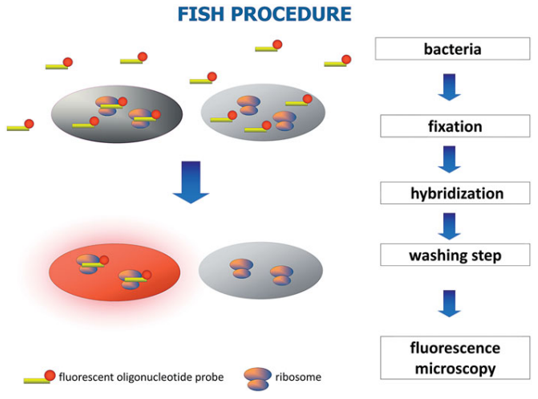Microbial Visualization
Microbial identification plays a key role in many studies, and the lack of morphological details of many bacteria and microorganisms often hinders their identification. According to classical microbiology, the traditional method of determining the composition of the microbial community requires cultivation on a selective medium, which is laborious, time-consuming and error-prone. It may also lead to the loss of information related to microbial composition. Due to its speed and sensitivity, fluorescence in situ hybridization (FISH) has become a method that can quickly identify and quantify the microorganisms present in the ecosystem and avoid cultivation. The application of rRNA-targeted species-specific probes makes this technology a powerful tool for microbial phylogeny, ecology, diagnosis and environmental research. Through this technology, microbiology knowledge in the fields of environment, medicine, food, etc. can be obtained. So far, FISH has been applied to the study of microbial symbiosis and microbial diversity in environmental samples and wastewater treatment. In medicine, it is also often used as a diagnostic tool in molecular mechanism research, to identify bacteria in complex communities in oral, respiratory and gastrointestinal disease models and samples, and to identify potential pathogens in human and animal tissues. Our microbial in situ hybridization technology service can identify different microorganisms in complex microbial communities, help understand interspecies interactions and assist in biological and medical research.
 Fig 1. Sequential procedures of FISH. (Frickmann H, et al. 2017)
Fig 1. Sequential procedures of FISH. (Frickmann H, et al. 2017)
Available Microbial FISH Services
Our microbial detection FISH service is a mature technical service that can detect microorganisms in samples of different types and sources, such as medical samples, food samples, environmental samples, and biofilm communities. FISH technology combines the precision of molecular genetics with the visual information of the microscope, which can visualize and identify individual cells in their natural microhabitats or diseased tissue samples so that they can be maintained without changing cell morphology or different compartments whole. If you have sex, check the nucleic acid sequence in the cell. The customization of our microbial FISH probes is the core of this service. In order to identify and quantify the microorganisms in the sample system, we use ribosomal RNA (rRNA) targeting oligonucleotide probes to complete related tests.
The service process includes probe customization, experimental protocol confirmation, sample submission, probe synthesis and labeling, FISH hybridization and data collection, and identification result reporting. Customers can consult our experts to understand the details of the experimental protocol before submitting samples. After the plan is determined, mail the sample to our laboratory. After we receive the samples, we will first conduct quality inspections on the samples and issue a quality control report. After completing the FISH test, our bioinformatics experts will give an identification report and a detailed analysis report. In addition, we also provide optional microbial CISH analysis and testing. The product and service process is basically the same as FISH. Welcome to email our technical team for details.
 Fig 2. Technical service process.
Fig 2. Technical service process.
Our Features
A variety of probe options, including specific rRNA oligonucleotide probes and nucleic acid analog probes;
Various application scenarios, such as food safety identification of food processing companies, etc.;
Combination options of multiple ways of products and services;
Choice of FISH or CISH multiple technologies;
Creative Bioarray provides available FISH technical services for microbial testing and research. We provide usable FISH solutions for biomedicine, food processing, environmental testing and other related research. A variety of technical service options and a complete technical platform can help researchers speed up the identification of microorganisms and the detection of regions of interest. If you are interested in our microbial visualization FISH service, please contact our technical colleagues for more information. We look forward to cooperating with you in the near future.
References
- Frickmann H, Zautner A E, Moter A, et al. Fluorescence in situ hybridization (FISH) in the microbiological diagnostic routine laboratory: a review[J]. Critical reviews in microbiology, 2017, 43(3): 263-293.
- Cerqueira L, Azevedo N F, Almeida C, et al. DNA mimics for the rapid identification of microorganisms by fluorescence in situ hybridization (FISH)[J]. International Journal of Molecular Sciences, 2008, 9(10): 1944-1960.


 Fig 1. Sequential procedures of FISH. (Frickmann H, et al. 2017)
Fig 1. Sequential procedures of FISH. (Frickmann H, et al. 2017) Fig 2. Technical service process.
Fig 2. Technical service process.


